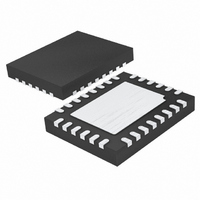LTC3850EUF#PBF Linear Technology, LTC3850EUF#PBF Datasheet - Page 11

LTC3850EUF#PBF
Manufacturer Part Number
LTC3850EUF#PBF
Description
IC CNTRLR STP DWN SYNC 28-QFN
Manufacturer
Linear Technology
Series
PolyPhase®r
Type
Step-Down (Buck)r
Datasheet
1.LTC3850EUFPBF.pdf
(38 pages)
Specifications of LTC3850EUF#PBF
Internal Switch(s)
No
Synchronous Rectifier
Yes
Number Of Outputs
2
Voltage - Output
0.8 ~ 23.3 V
Current - Output
100mA
Frequency - Switching
250kHz ~ 780kHz
Voltage - Input
4 ~ 24 V
Operating Temperature
-40°C ~ 85°C
Mounting Type
Surface Mount
Package / Case
28-QFN
Primary Input Voltage
24V
No. Of Outputs
2
Output Current
100mA
No. Of Pins
28
Operating Temperature Range
-40°C To +85°C
Msl
MSL 1 - Unlimited
Supply Voltage Range
4V To 24V
Rohs Compliant
Yes
Lead Free Status / RoHS Status
Lead free / RoHS Compliant
Power - Output
-
Available stocks
Company
Part Number
Manufacturer
Quantity
Price
OPERATION
Main Control Loop
The LTC3850 is a constant-frequency, current mode step-
down controller with two channels operating 180 degrees
out-of-phase. During normal operation, each top MOSFET
is turned on when the clock for that channel sets the RS
latch, and turned off when the main current comparator,
I
which I
on the I
fier EA. The V
which is compared to the internal reference voltage by the
EA. When the load current increases, it causes a slight
decrease in V
turn causes the I
inductor current matches the new load current. After the
top MOSFET has turned off, the bottom MOSFET is turned
on until either the inductor current starts to reverse, as
indicated by the reverse current comparator I
beginning of the next cycle.
INTV
Power for the top and bottom MOSFET drivers and most
other internal circuitry is derived from the INTV
the EXTV
4.7V, an internal 5V linear regulator supplies INTV
from V
turned off and an internal switch is turned on connecting
EXTV
to be derived from a high efficiency external source such
as one of the LTC3850 switching regulator outputs.
Each top MOSFET driver is biased from the floating boot-
strap capacitor C
off cycle through an external diode when the top MOSFET
turns off. If the input voltage V
close to V
to turn on the top MOSFET continuously. The dropout
detector detects this and forces the top MOSFET off for
about one-twelfth of the clock period every third cycle to
allow C
load be present during the drop-out transition to ensure
C
CMP
B
is recharged.
, resets the RS latch. The peak inductor current at
CC
CC
IN
CMP
/EXTV
B
. Using the EXTV
TH
. If EXTV
CC
to recharge. However, it is recommended that a
OUT
pin, which is the output of each error ampli-
resets the RS latch is controlled by the voltage
pin is left open or tied to a voltage less than
CC
FB
, the loop may enter dropout and attempt
FB
pin receives the voltage feedback signal,
Power
CC
relative to the 0.8V reference, which in
B
TH
, which normally recharges during each
is taken above 4.7V, the 5V regulator is
voltage to increase until the average
CC
pin allows the INTV
IN
decreases to a voltage
CC
REV
pin. When
CC
CC
, or the
power
power
Shutdown and Start-Up (RUN1, RUN2 and TK/SS1,
TK/SS2 Pins)
The two channels of the LTC3850 can be independently
shut down using the RUN1 and RUN2 pins. Pulling either
of these pins below 1.2V shuts down the main control
loop for that controller. Pulling both pins low disables both
controllers and most internal circuits, including the INTV
regulator. Releasing either RUN pin allows an internal
0.5µA current to pull up the pin and enable that control-
ler. Alternatively, the RUN pin may be externally pulled up
or driven directly by logic. Be careful not to exceed the
Absolute Maximum Rating of 6V on this pin.
The start-up of each controller’s output voltage V
controlled by the voltage on the TK/SS1 and TK/SS2 pins.
When the voltage on the TK/SS pin is less than the 0.8V
internal reference, the LTC3850 regulates the V
to the TK/SS pin voltage instead of the 0.8V reference. This
allows the TK/SS pin to be used to program a soft-start
by connecting an external capacitor from the TK/SS pin
to SGND. An internal 1.3µA pull-up current charges this
capacitor, creating a voltage ramp on the TK/SS pin. As the
TK/SS voltage rises linearly from 0V to 0.8V (and beyond),
the output voltage V
value. Alternatively the TK/SS pin can be used to cause the
start-up of V
this requires connecting to the TK/SS pin an external resistor
divider from the other supply to ground (see the Applica-
tions Information section). When the corresponding RUN
pin is pulled low to disable a controller, or when INTV
drops below its undervoltage lockout threshold of 3V, the
TK/SS pin is pulled low by an internal MOSFET. When in
undervoltage lockout, both controllers are disabled and
the external MOSFETs are held off.
Light Load Current Operation (Burst Mode Operation,
Pulse-Skipping, or Continuous Conduction)
The LTC3850 can be enabled to enter high efficiency Burst
Mode operation, constant-frequency pulse-skipping mode,
or forced continuous conduction mode. To select forced
continuous operation, tie the MODE/PLLIN pin to a DC
voltage below 0.8V (e.g., SGND). To select pulse-skipping
mode of operation, tie the MODE/PLLIN pin to INTV
select Burst Mode operation, float the MODE/PLLIN pin.
OUT
to “track” that of another supply. Typically,
LTC3850/LTC3850-1
OUT
rises smoothly from zero to its final
FB
11
voltage
OUT
CC
38501fc
. To
CC
CC
is













